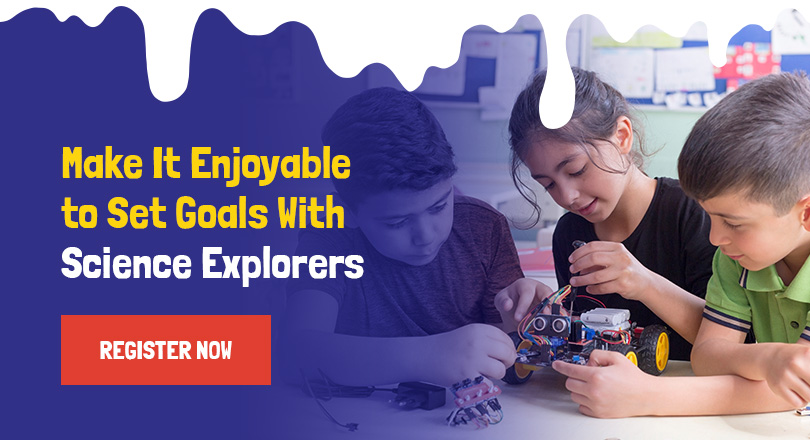To feel self-confident and enjoy success, children need a variety of valuable skill sets, such as being able to identify, track and meet goals. Yet goal setting for kids often goes by the wayside in favor of teaching them how to perform other tasks.
Instead of letting kids “find their way” when it comes to mapping out short-term and long-term goals, help them master this skill early. They’ll benefit from your diligence by having a stronger sense of purpose and control.
How to Start Setting Learning Goals for Children
One of the best ways to introduce the concept of setting goals is to make objectives for yourself and then share them with your youngster or, if you’re a teacher, with your students.
For instance, you might be training to enter a 5K race. In that case, write the big goal at the top of a piece of paper: “Complete a 5K Race.” Under the big goal, note all the things you’ll do to achieve it. These can include running a certain number of miles each week, adding more nutritious items to your diet and investing in proper running shoes.
Walk your child through your objectives and ask them to help you accomplish the resolution. Children usually love to help the adult role models in their lives. Not only will you get a dedicated cheerleader, but you’ll help your child see the excitement and rewards of goal setting.
Once your objective is underway or completed, ask your child to try goal setting, too! Below are a few tips for creating doable learning resolutions for elementary students.
Set SMART Goals
Learning how to establish SMART goals helps a child become more focused and responsible on achieving their objectives. This acronym stands for:
- Specific: Your goal is detailed and exact. It usually answers the questions who, what, when, where, why and which.
- Measurable: You can track your progress by involving numbers to know exactly when your goal is met.
- Attainable: The goal is reasonable. It is within reach and a challenge for growth.
- Relevant: Your goal is worthwhile. It is something that is important to you right now.
- Timely: You can accomplish your goal within a certain time frame or by a specified date, such as two weeks or a year.
The first objective your child writes down should be well within their reach. First learning goals for elementary students could include objectives like eating veggies and hummus after school instead of junk food for a week or walking the dog for 15 minutes every day.
SMART learning goals for kids can be written in any way you like. However, it’s great to use a checklist format so your child can check off each step of the resolution as they accomplish it.
Move on to Learning-Based Goals
After your child gets a taste of how exciting and gratifying meeting objectives can be, encourage him or her to develop educational goals. That is, objectives that have a learning-specific component.
Be careful to frame the resolution in a positive way and emphasize the action. If your child struggles with math, the goal shouldn’t be: “I won’t get D grades anymore.” This objective is vague and may become a de-motivator. A better goal would be: “I will spend 30 minutes every weeknight with my mom working on my math homework.”
By encouraging this behavior now, you’re setting the stage for healthier studying habits that will help your child in the future!
Make Goal Setting a Fun Activity
Teaching your child to set SMART goals is a great tactic for their skill development. To ensure they retain the information, make it fun! Elementary-aged students tend to learn best in hands-on activities. Here are some ways to help them enjoy goal setting — and follow through with it.
- Make a group bucket list: Work as a family or class to set some tasks or experiences you want to accomplish together. At the end of the year, look back on everything you have completed!
- Create a vision board: Help your child map out their hopes and dreams with this arts and crafts activity. Take some old magazines and have your child cut and paste photos or words that represent their goals on a piece of paper.
- Draw a goal ladder: Have your child write their goal on the top step of the ladder. Help them come up with achievable goals and write them on each rung of the ladder.
Allow for Goal Setting Setbacks
You and your child (or student) may set realistic and measurable learning goals. Nevertheless, life happens, which means that the resolutions might take longer than expected to complete.
If you experience setbacks, work with your child to revise the original resolution. Maybe the objective was too complex and should be broken down into smaller pieces. Or perhaps it isn’t as critical as another goal that deserves more attention right now. Overall, stay positive and encouraging. These are good life lessons!
Showing a child how to adapt their goals (but not forgo them altogether!) encourages creativity and practicality. This practice also opens up the opportunity for you to have thoughtful conversations about objectives. You’d be amazed at how wise kids can be about goal setting when they start to get the hang of it.
Make It Enjoyable to Set Goals With Science Explorers
You should always find time to celebrate when your child reaches their objectives. Throw a small party. Buy a little present for them. Have a class pizza party when all your students achieve their goals.
The more positive you frame the goal-setting process, the more likely your child will continue setting and meeting objectives in their life.
Is one of your child’s learning goals to explore the world of STEM? Sign up for an in-person or virtual Science Explorers after-school club today!


